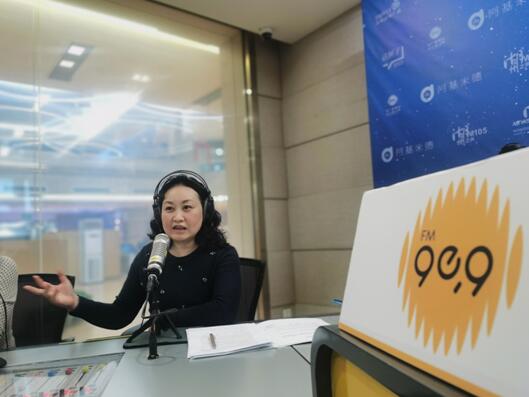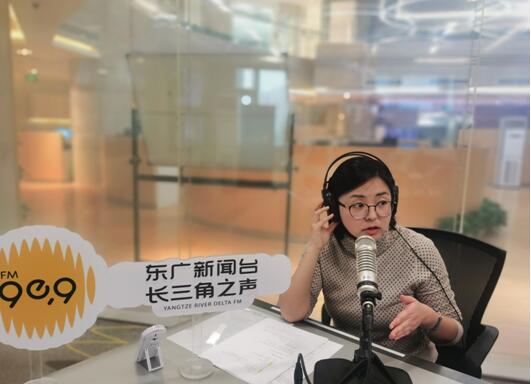Dongguang News Radio "Yangtze River Delta avant-garde" interviewed World Expo Museum
日期:01-03-2020来源:World Expo MuseumOn the morning of December 26, the Voice of the Yangtze River Delta,"Yangtze River Delta Avant-garde" from Dongguang News Radio interviewed Liu Xiuhua, the director of World Expo Museum, and Hong Lina, the curator of the Exhibition of Expo Historical Documentations. The main topice of this interview is" To view the Integration and Development of the Yangtze River Delta from Historical Documents Exhibition ".

At the beginning of the show, the Expo song "We Are All This Together" immediately evoked the audience's memories of Expo 2010. As long as you have been to the Expo Park that year, you will definitely have an impression of this song. Today, the original Puxi area of the World Expo is developing into a new landmark for cultural exhibitions. There is not only the World Expo Museum which is the world ’s first expo themed museum and the largest museum in Puxi, but also the very popular Shanghai Museum of Contemporary Art, The Urban Best Practice Area (UBPA) and the Shanghai Children's Art Theater (SAIC Roewe Children's Cultural Center). Each venue has its own characteristics, and exhibition activities are launched from time to time.
The World Expo Museum is the first venue in Puxi to be opened in the post-Expo cultural area. It has been open for two and a half years and attracts many visitors every weekend and holiday. The "Expo History Documents Exhibition" which was recently on display in the No. 1 temporary exhibition hall of the museum is the world's first special exhibition featuring precious historical documents as the main exhibits. The exhibition will be open to the public for free until February 9 next year.
In the program, Hong Lina, the curator of the documentary exhibition, shared her own development process from attending the exhibition as a regular Expo visitor in 2010 to a professional Expo researcher of the Expo museum. She introduced the historical stories behind the Expo documents in an easy-to-understand manner, and shared with the audience the highlights and fun of the exhibition in terms of the professionalism, interest, and interaction of the exhibition.

She specifically introduced "The First Travel notes of the Chinese Around the globe". In 1876, the Qing government was invited to organize a delegation to participate in the World Expo in Philadelphia. In the early days of Qing government's participation in the World Expo, Daqing customs department was usually authorized to attend expo on the government’s behalf, while customs officials at that time were mostly foreigners. Li Gui, a Zhejiang native, was the secretary of the Deputy Taxation Department of Ningbo Customs and participated in the expo. He was also the only Chinese in the Chinese delegation of the World Expo in Philadelphia. He set out from Shanghai. After the Philadelphia World Expo ended, he also traveled to the United States, Britain, and France before returning to Shanghai. In 1878, Li Gui published the book "A New Record of Traveling Around the Earth", which was the first Chinese travel note of travelling around the globe and the first Chinese monograph detailing the World Expo. In the early World Expo, there were already many exhibits brought by businessmen from Jiangsu and Zhejiang, and they won many awards. The origin of the popular small-packaged tea today is from what Chinese learned form world Expo. Zhejiang merchants came to the World Expo to understand the needs of the Western market and improve the packaging. The bulk tea they took could not be sold at the World Expo. After research, it turned out that Westerners like small packages.
The World Expo Museum not only records the historical materials of Jiangsu and Zhejiang businessmen in the Yangtze River Delta region participating in the World Expo. Since its opening in 2017, the museum has held cooperative exhibitions with the Yangtze River Delta regional museums, and has launched Expo Halls in campuses with schools in the Yangtze River Delta. Educational activities. Director Liu introduced that in September this year, the “Cha Shi zhi ya” special exhibition presented by the museum and the China Tea Museum cooperated to share resources through inter-library cooperation, tapping the strengths and potentials of different museums, and the exhibition also consolidated The centripetal force between the Yangtze River Delta museums, and provides a platform and display window for the integrated development of the Yangtze River Delta Museum.
In May last year, our museum and a total of 29 units in the Yangtze River Delta established the "Yangtze River Delta Museum Education Alliance" to focus on the educational functions of the museum, and use the museum's unique cultural resources and communication methods to create a gold card for museum education to promote the Expo culture Linkages in the Yangtze River Delta. The museum ’s Expo Lecture Hall took the initiative to spread out. Since May last year, the course has been taken out from Shanghai for the first time. The mission team has entered Anhui, Nanjing, Yangzhou, and Lianyungang, 17 schools of four Yangtze River Delta areas. 58 interesting courses about expo in architecture, transportation, technological development, arts, cuisine, navigation, world civilization and other aspects was brought to primary and middle school students.
Through this live broadcast, the World Expo Museum Document Exhibition and social education activities have been further publicized. We look forward to attracting more Expo friends to the Expo Museum in the future, and to experience the wonderful Expo and inspire a better future!